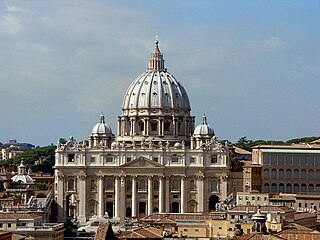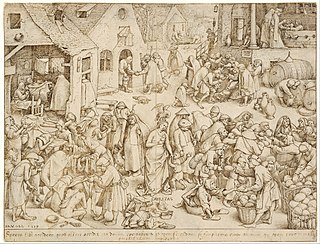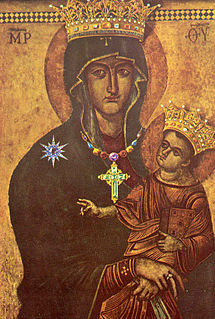
Humanae vitae is an encyclical written by Pope Paul VI and dated 25 July 1968. The text was issued at a Vatican press conference on 29 July. Subtitled On the Regulation of Birth, it re-affirmed the teaching of the Catholic Church regarding married love, responsible parenthood, and the rejection of artificial contraception. In formulating his teaching he explained why he did not accept the conclusions of the Pontifical Commission on Birth Control established by his predecessor, Pope John XXIII, a commission he himself had expanded.

Pope John Paul II was the head of the Catholic Church and sovereign of the Vatican City State from 1978 until his death in 2005. He was elected pope by the second papal conclave of 1978, which was called after John Paul I, who had been elected in August to succeed Pope Paul VI, died after 33 days. Cardinal Wojtyła was elected on the third day of the conclave and adopted the name of his predecessor in tribute to him. John Paul II is recognised as helping to end Communist rule in his native Poland and the rest of Europe.

The Second Ecumenical Council of the Vatican, commonly known as the Second Vatican Council, or Vatican II, addressed relations between the Catholic Church and the modern world. The Council, through the Holy See, was formally opened without invoking infallibility under the pontificate of Pope John XXIII on 11 October 1962, and was closed, though not declared an infallible council, under Pope Paul VI on the Solemnity of the Immaculate Conception on 8 December 1965.

Ad gentes is the Second Vatican Council's decree on missionary activity. The title is Latin for "To the Nations," and is from the first line of the decree, as is customary with Roman Catholic documents. It establishes evangelization as one of the fundamental missions of the Catholic Church and reaffirms the tie between evangelization and charity for the poor. Ad gentes also calls for the formation of strong Christian communities as well as strong relations with other Christians. Finally, it lays out guidelines for the training and actions of the missionaries.

The Catechism of the Catholic Church is a catechism promulgated for the Catholic Church by Pope John Paul II in 1992. It sums up, in book form, the beliefs of the Catholic faithful.

Catholic charismatic renewal is a "current of grace" within the Catholic Church that incorporates aspects of both Catholic and charismatic movement practice. It is influenced by some of the teachings of Protestantism, Eastern Orthodoxy and Pentecostalism with an emphasis on having a "personal relationship with Jesus" and expressing the "gifts of the Holy Spirit".

Theology of the Body is the topic of a series of 129 lectures given by Pope John Paul II during his Wednesday audiences in St. Peter's Square and the Paul VI Audience Hall between September 5, 1979, and November 28, 1984. It constitutes an analysis on human sexuality. The complete addresses were later compiled and expanded upon in many of John Paul's encyclicals, letters, and exhortations.

The history of the Catholic Church is integral to the history of Christianity as a whole. It is also, according to church historian, Mark A. Noll, the "world's oldest continuously functioning international institution." This article covers a period of just under two thousand years

The teachings of Pope John Paul II are contained in a number of documents. It has been said that these teachings will have a long-lasting influence on the Church.

Mystici corporis Christi is a papal encyclical issued by Pope Pius XII on 29 June 1943 during World War II. It is principally remembered for its statement that the Mystical Body is identical with the Roman Catholic Church, repeated by Pius XII in Humani generis (1950) in response to dissension. According to Mystici corporis, to be truly (reapse) a member of the Mystical Body one must be a member of the Roman Catholic Church. Other Christians who erred in good faith could be unsuspectingly united to the Mystical Body by an unconscious desire and longing.

Works of mercy are practices considered meritorious in Christian ethics.
Ut unum sint is an encyclical by Pope John Paul II of 25 May 1995. It was one of 14 encyclicals issued by John Paul II. Cardinal Georges Cottier, Theologian emeritus of the Pontifical Household, was influential in drafting the encyclical.
Redemptor hominis is the name of the first encyclical written by Pope John Paul II. It lays a blueprint for his pontificate in its exploration of contemporary human problems and especially their proposed solutions found in a deeper understanding of the human person. The encyclical was promulgated on 4 March 1979, less than five months after his installation as pope.
Redemptoris missio, subtitled On the permanent validity of the Church's missionary mandate, is an encyclical by Pope John Paul II published on 7 December 1990. The release coincided with the twenty-fifth anniversary of Vatican II's Decree on the Church's Missionary Activity, Ad gentes. It is devoted to the subject of "the urgency of missionary activity" and in it the pope wished "to invite the Church to renew her missionary commitment."
Mediator Dei, a papal encyclical, was issued by Pope Pius XII on 20 November 1947. It was the first encyclical devoted entirely to liturgy.

The theology of Pope Pius XII is reflected in his forty-one encyclicals, as well as speeches and nearly 1000 messages, during his almost 20-year pontificate. The encyclicals Mystici corporis and Mediator Dei advanced the understanding of membership and participation in the Catholic Church. The encyclical Divino afflante Spiritu began opening the door to historical-critical biblical studies. But his magisterium was far larger and is difficult to summarize. In numerous speeches Catholic teaching is related to various aspects of life, education, medicine, politics, war and peace, the life of saints, Mary, the mother of God, things eternal and temporal.

The Mariology of the popes is the theological study of the influence that the popes have had on the development, formulation and transformation of the Roman Catholic Church's doctrines and devotions relating to the Blessed Virgin Mary.

A Marian year is a designation given by the Catholic Church to calendar years in which Mary the mother of Jesus is to be particularly reverenced and celebrated. Marian years do not follow a set pattern. They may be declared by a bishop for his diocese, or a national conference of bishops for a country. In Church history, only two international Marian years have been pronounced, by Pope Pius XII in 1954, and Pope John Paul II in 1987.

The theology on the body is a broad term for Catholic teachings on the human body.

The Pope John Paul II bibliography contains a list of works by Pope John Paul II, and works about his life and theology. Pope John Paul II reigned as pope of the Catholic Church and sovereign of Vatican City for 26 years and six months. Works written and published prior to his election to the papacy are attributed to Karol Wojtyła. Additional resources can be found on the Vatican website.














